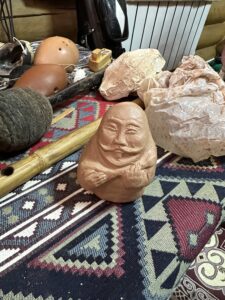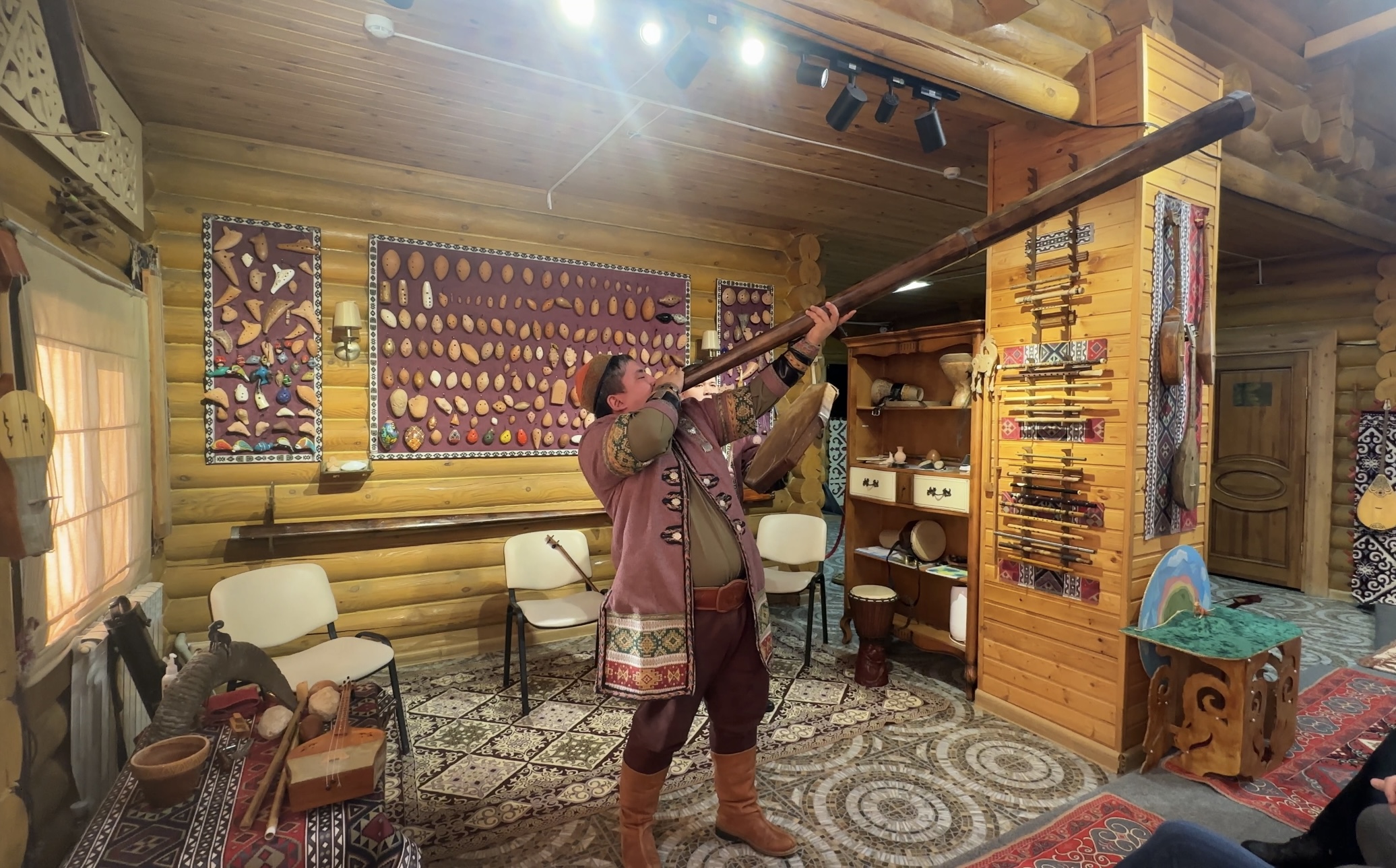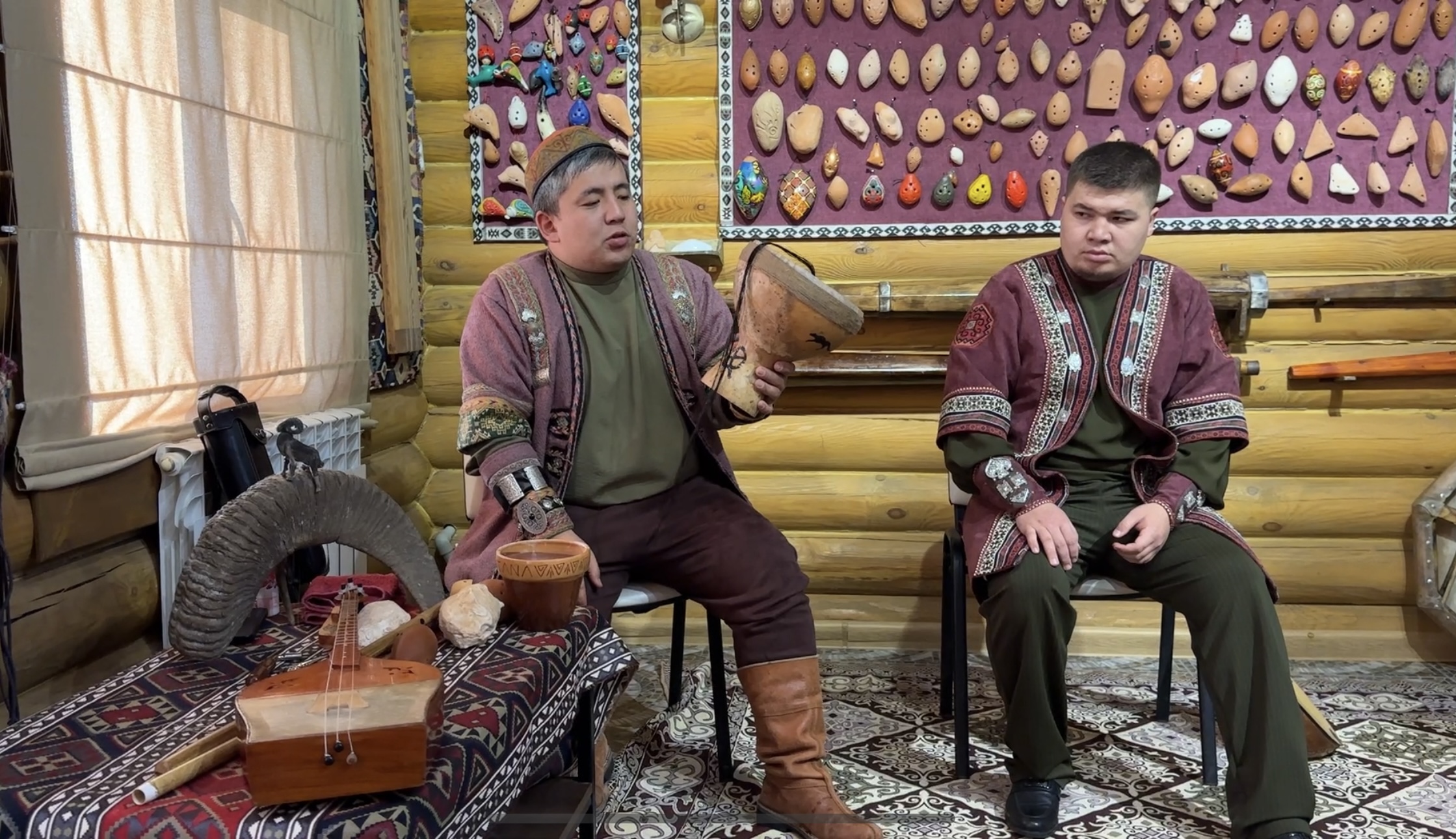AKMOLA REGION – A beguiling new museum in the Kosshy village, a 20-minute drive from Astana, is showcasing an excellent collection of over 1,600 Kazakh and Turkic instruments in an effort to preserve and revive the rarest pieces.

Museum’s founder Azamat Bakiya playing on sazsyrnai. Photo credit: Aibarshyn Akhmetkali/The Astana Times
A love letter to rich Kazakh musical heritage, the small museum is much more than a series of instruments hanging on a wall. It is an interactive museum, where visitors are welcome to listen to, pick up, and try some of the less precious pieces and even make their own instruments.
Founded in 2023 by a musician and instrument maker, Azamat Bakiya, it aims not only to explain the contexts within which the instruments were used back in the day but also to show how one plays an instrument and what it sounds like.
Why settle for a recorded sound when one could hear a live performance culminating in all instruments playing traditional Kazakh kui (music) in a small orchestra made by the museum’s masters?
Sazsyrnai
From early childhood, Bakiya was particularly captivated by the sazsyrnai. During the visit, he shared his lifetime relationship with one of the country’s oldest musical instruments, which dates back to the ninth century.

Freshly made sazsyrnai. Photo credit: Aibarshyn Akhmetkali/The Astana Times
“I have been making instruments since I was 12 years old. The first instrument I made was the sazsyrnai. There was a movie called ‘Batyr Bayan.’ In that movie, after killing his brother Noyan, Batyr Bayan leaves the sazsyrnai in that place. I cried to my parents for two years asking them to take me there and take the sazsyrnai,” said Bakiya, reminiscing about his first love for the instrument.
Since then, he has struggled through many burnt and broken sazsyrnais before becoming one of the most prominent masters. He can now make a sazsyrnai in 40 seconds. His workshop makes up to 100 sazsyrnais in a day.
At first glance, sazsyrnai appears to be an ordinary round whistling instrument made of clay with four holes. Its true beauty is revealed only in the hands of a loving player. A miracle of efficient design in compact size allows all kinds of music to be played on it.
With delicate sound, sazsyrnai reminds a person of a mother’s lullaby soothing one to sleep, yet it also has quite an expressive range that goes up to 4.5 octaves.
Kernei
There are only two remaining pieces of kernei, a traditional horn-like instrument, in Kazakhstan and both of them are at Bakiya’s museum. It is an ancient Kazakh wind instrument that has a very powerful sound.

Bakiya playing the kernei instrument. Photo credit: Aibarshyn Akhmetkali/The Astana Times
Kernei varies in size, with some as long as two meters. It is thought to have been used ceremonially during military battles and to deliver messages over long distances.
“This instrument is mentioned in the heroic poem of ‘Alpamys.’ One of the purposes of this instrument was to honor the young men returning from the battle with victory by walking them under the kerneis. According to our scholar Zharkyn Shakarim, it was used during the war. This was a very big thing that kept the army in line and inspired them,” said Bakiya.
Bakiya’s one blow into the instrument, which is above his height, is pretty impressive. Its sound could reach up to four kilometers.
“Another way to use it was by putting five kernei players every four kilometers, which would disperse the sound as far as 20 kilometers. They used to spread the military message for 20 kilometers like the Morse alphabet. Because the ‘code’ was constantly changing, no kui (traditional Kazakh music) was preserved,” added Bakiya.
Donyz kauak
Besides the wind and string instruments, there are many types of drums of different sizes and shapes that make up Kazakh traditional music. The most intriguing of them is the donyz kauak drum, which has a sound that mimics a tiger’s voice.

Bakiya (L) telling the captivating story behind dunyz kauak instrument. Photo credit: Aibarshyn Akhmetkali/The Astana Times
“Our country was inhabited by a tiger known as the Turanian tiger. In 1929, during the construction of Turksib (Turkistan-Siberia railroad), the British took a picture of it,” said Bakiya in the story’s preface.
“Then, back in 1969, while some Kazakhs planted crops, others still kept livestock. So, someone’s cattle got into the crop, and they quarreled with each other. It even went as far as trying to shoot the cattle. At that time, someone’s grandmother said that there is an instrument called ‘donyz kauak,’ and if you play it, the animals will be scared,” added Bakiya.
Donyz kauak is made from kauak (pumpkin family plant) and covered with animal skin. It has bristles, usually made from the hairs of a horse’s tail. The player waters his hands and pulls the bristles of the instrument with one hand to produce a whooping sound that resembles a tiger.
It was once used to scare off tigers in the thick reeds when villagers searched for lost cattle while traveling from village to village. A tiger stays out of the reeds when he hears that there is another tiger around.
Shankobyz
Little is known about the history of shankobyz in Kazakhstan, but it is an instrument that has strong links to rituals performed by the baksy (shamans).
A pulsating sound that shankobyz produces is almost hypnotic. According to Bakiya, even a five-minute play on the instrument could make a person dizzy. It was believed that its powerful tones could affect the person being treated by a baksy.
Producing such evocative sounds takes no small amount of craft, as Bakiya puts it.
“This instrument is available in almost all countries of the world, not only in Kazakhstan. It is highly developed in Yakutia. Artists of that country are considered the world’s best artists. A world competition was held there too,” said Bakiya.
The museum is situated at the following address: 24a Zhabayeva Street, Kosshy.

